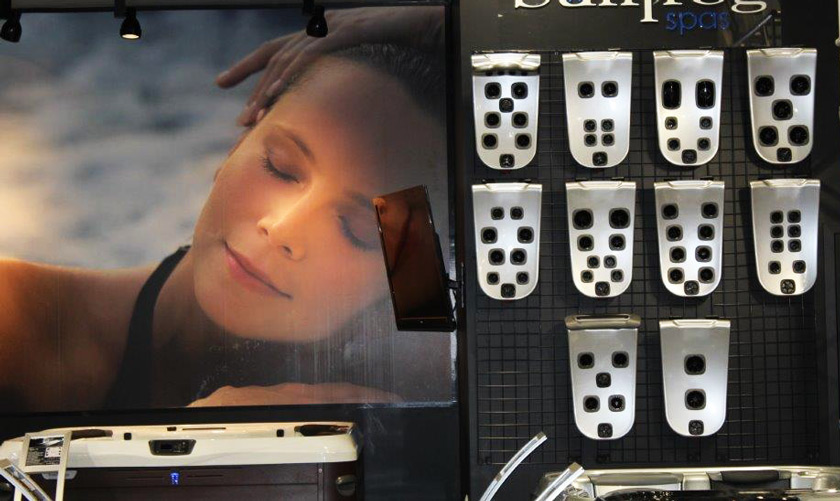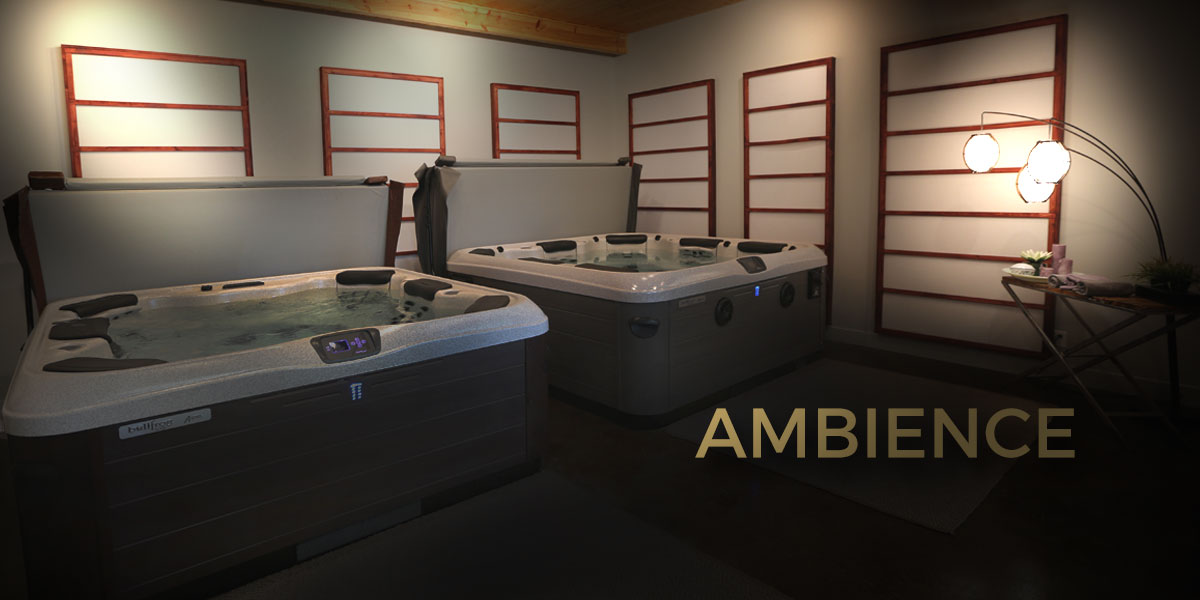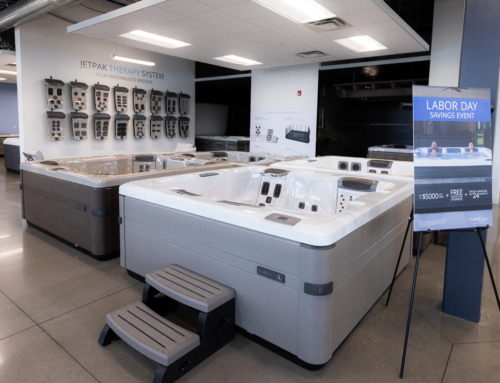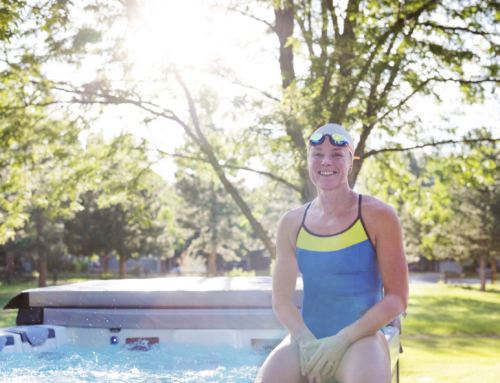When it comes to purchasing hot tubs, consumers are generally influenced by two factors: product and price. Consumers first look for what they want, then haggle over price.
But when products and price are comparable (as is the case for many spa retailers), what can spa dealers do to give their businesses an edge?
Atmosphere is the answer.
Building Atmosphere
The atmospherics of your showroom really can make the difference between a showroom that shows and a showroom that sells.
Atmospherics were originally defined as the effort to design buying environments to produce specific emotional effects in the buyer that enhance his/her purchase probability. This idea referred to leveraging the psychological impacts of a person’s five primary senses on decision-making. Basically, retailers don’t need to change the product or advertising to see more sales. All they have to do is create an environment that entices customers.
There is a well-established body of research on the value of creating a comprehensive shopping experience through creative use of lighting, arranged displays, and space, and few have taken that to heart as well as Eric Mercier, sales manager for Piscene Hippocampe located in Delson, Quebec. The store underwent a massive remodeling two years ago, and since then he attributes about 25% of the store’s sales growth to innovative changes to the ambience. (It’s amazing how even ambience can be influenced by the I-word.)

Photo courtesy Piscine Hippocampe
The goal of an atmospheric shopping experience is immersion, he says. Comfortable customers who are immersed in their environment tend to forget that they’re out shopping and are more likely to stick around and browse. This keeps customers in the store longer and gives your sales reps more time to find the right solution.
Mindful showroom ambience also reinforces the value of your product within your customers’ minds. Deliberate atmospheric choices subconsciously deliver information to each customer. In turn, these psychological messages influence each customer’s perception of your showroom display and reinforce the value you provide. But showroom ambience is about more than mere psychology—it can produce real, bankable benefits as well. Research on the ROI of retail design showed that interior showroom factors significantly contributed to the consumer’s overall experience, influencing sales, brand awareness, customer loyalty, and even social media impact. These benefits are nothing to sneeze at—the above research also found that retail businesses, like spa dealerships, showed the highest proportion of revenue gain for every improvement made to the customer experience.
But the practice isn’t just theoretical, says Nicole Pasley, Store Manager at Bullfrog Spas in Orem, Utah. “We actually included some patio furniture in our showroom that we now sell, and just getting that in there has helped people to be able to envision having a hot tub in their backyard,” she said. “Even if we weren’t selling the patio furniture, it’s helped us quite a lot in that store experience.”
To make the point, she provided a few tips for making the most out of a showroom’s ambience.
Music
The choice of music in your showroom can also influence customer perceptions of your business.
Background music is a powerful tool to help customers relax and feel at home—as long as it’s handled right. Your musical choices must align with the goals of your business and the preferences of your market.
Typically, calm and soothing music helps customers relax and can even help them visualize how your spas will look in their own homes. Songs from our younger days tend to resonate best with our psychology; aim for tracks that were in vogue during your target market’s early to mid-20s. For most spa buyers, these songs will have been hits between the mid-‘70s and the mid-‘90s. Choosing relaxed tunes from these eras will trigger nostalgia in your markets and subconsciously relax them, making them more attuned to the products on display. Plus, it gives your staff something to groove to during business hours.
Lighting
A key addition to the Piscene Hippocampe showroom floor was the installation of spotlight lighting, Mercier says.
“When the lights shine on the spa, it looks majestic, like a paradise in the middle of the showroom,” he said. “It’s about making the product look special.” Doing so helps the customer tune out other visual cues and focus on just the product, he added.
The lighting of your showroom’s interior can greatly influence your customers’ state of mind. The goal is to find an ambient sweet spot between brightness and dimness—harsh, bright lights reflect off of typical spa product surfaces and create unattractive glares.
However, lighting that is too low will fail to illuminate your displayed products and can make craftsmanship hard to see. It’s also vital to clean each spa continuously to help it shine better in the light, Mercier adds. His salespeople consistently wipe their spas down several times during the day, often during downtime.
For the most appropriate mood lighting, think date night. Aim for soft, indirect light sources to illuminate the room while leveraging brighter track lighting for each specific display.
Colors
There is plenty of science to support the connection between color and emotion. Cool colors, such as blues and greens, are soothing. Warmer colors, such as oranges and reds, are stimulating. Metallic colors, along with black and white reflect luxury. Your market’s in-store experience will be greatly affected by your choice of showroom color scheme.
Prioritize neutral, earthy tones that don’t distract viewers from your product line. Earthy browns and greens help customers subconsciously internalize how your spas may look in natural environments, such as their own backyards. Take advantage of this by creating relaxing and natural color environments in your showroom.
Remember: Effective color design is just as much about what you avoid as what you choose. White, blank walls appear drab and give an unfriendly and sterile impression. Bright, clashing colors are distracting, unpleasant to look at, and can appear unprofessional. Prioritize soft, inviting colors that are easy on the eyes and comforting to your shoppers.
Scents
Speaking of I-words, one of the best ways to increase customer immersion and influence purchasing is by leveraging the power of scent (which starts with an S).
Research has shown that olfactory stimuli have a tremendous impact on memory, mood, and consumer behavior—a bigger impact than any other of our senses, in fact. This is why so many realtors bake cookies in the homes they’re showing; positive scents lead to positive emotions. You can use the same strategy inside your spa showroom.
Sure, you probably don’t have an oven in the middle of your store, but warm, inviting fragrances like lavender, fresh linen, or spice can trigger powerful sense reflexes in your customers and get them in a positive mood before they even speak with a sales rep. And even if you don’t use specific fragrances, take care to get rid of any unpleasant odors that your showroom may have. Plastic-like odors reminiscent of hospitals, for example, simply won’t do a thing to reinforce positivity in the minds of your customers!
Plants
Including plant life in a spa showroom is an easy way to improve audience engagement and attentiveness to your product line.
According to data compiled by Psychology Today, including plant life in your otherwise barren showroom may have benefits that include:
- Increased customer attentiveness
- Improved perceptions of the showroom space
- Improved sensations of well-being overall
On top of that, plants and flowers smell fresh and complement the earthy color tones that your showroom should have. There’s really no drawback—add a few plants to your showroom to give it a fresh and lively feel.
Point of Purchase Displays
Point of Purchase (POP) displays are essential for showroom conversions. If the overall goal of your showroom is to convert customers from mere prospects into revenue-generating purchasers, POP displays can be your secret weapon for success. Think of POP displays as a different aspect of your showroom ambience. Effective POP displays build your showroom’s atmosphere by establishing a sense of polish and professionalism that carefully crafted marketing materials provide.
Building Emotion
But POP displays aren’t just another aspect of your showroom atmosphere. POP displays should elicit emotion from customers—ideally, excitement and enthusiasm about your product. Emotion is a powerful driver of sales, and emotion-oriented POP displays can enhance the sales process for your customers and your sales team.
Above all, POP displays are designed to empower your sales team to make conversions easier. Use customer feedback to determine what resonates with your audience to get the most out of your product line.
Product Demonstrations
Ambience involves every aspect of a customer’s shopping experience, including what they do in the showroom. Pasley suggests that spa retailers offer “wet” spas on the showroom floor that allow prospects try out the product before purchasing.
This is a powerful strategy for immersion—spa demos engage all five senses in the customers who try them. The impact of this sensory engagement on conversions can be significant, particularly for customers who are already interested but aren’t ready to close the deal. When customers feel the warmth of the water, smell the aromatic fragrances, and visualize how well their potential spa will look in their own backyard, sales growth won’t be far behind.
Create the Right Showroom Ambience for Your Buyers
The bottom line is, the success of your spa enterprise relies on carefully crafted ambience and a planned out showroom. And while sheer square footage helps, it’s not close to the most important factor.
“Even if you have a smaller space, it can be a little bit easier because you can really make that cozy environment,” Pasley said. When you walk into a lot of spa stores, it’s basically tubs lined up, a very sterile environment. Anything you can do to add the warmth, make it feel more homely, and make it feel more like a backyard is going to help a lot. You don’t necessarily need the large space.”
These days, consumers are empowered by the wealth of information available on the Internet, and businesses have to stand out any way they can. When products and pricing are similar across the board, it falls to the in-store experience to influence the customer’s final decision.
Successful spa retailers must understand this and tailor their showrooms accordingly. Make deliberate efforts to plan your color scheme, lighting, music choice, and placement of displays. Each of these elements can have a significant impact on buyer psychology. When each element of your showroom has been crafted to drive consumers toward the point of purchase, your team will have an even easier time closing the sale—with or without an I-word.









Leave A Comment